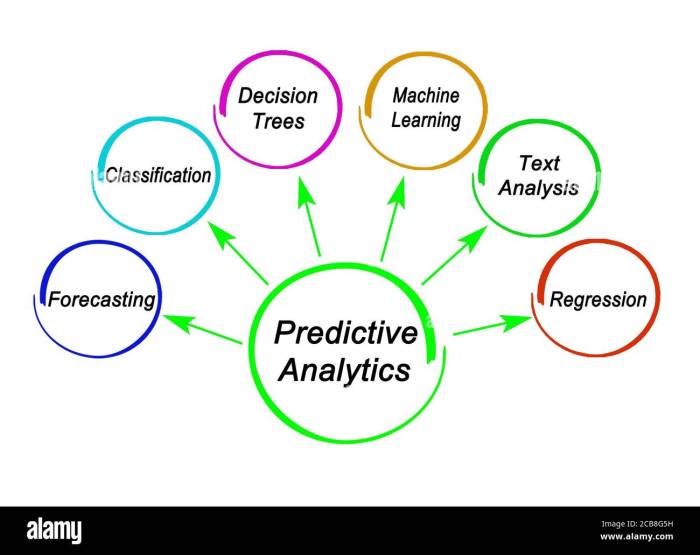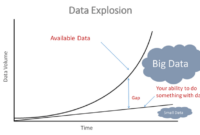Predictive analytics tools take center stage in the business world, offering a glimpse into the future of data-driven decision-making. This comprehensive guide explores the various facets of these tools, shedding light on their significance and impact across industries.
Overview of Predictive Analytics Tools
Predictive analytics tools are software solutions that utilize data, statistical algorithms, and machine learning techniques to identify the likelihood of future outcomes based on historical data. These tools help businesses make informed decisions by predicting trends, behaviors, and outcomes.
Benefits of Predictive Analytics Tools
- Increased Sales and Revenue: Industries such as retail and e-commerce can use predictive analytics tools to forecast customer demand and optimize pricing strategies, leading to increased sales and revenue.
- Improved Operations: Manufacturing and supply chain industries can leverage predictive analytics tools to predict equipment failures, optimize inventory management, and enhance operational efficiency.
- Enhanced Marketing Campaigns: Marketing and advertising industries can benefit from predictive analytics tools by analyzing customer behavior, segmenting target audiences, and personalizing marketing campaigns for better engagement and conversion rates.
Types of Predictive Analytics Tools

Predictive analytics tools come in various types, each serving different purposes and catering to specific business needs. It is essential to understand the differences between these tools to choose the right one for your organization.
Open-Source Predictive Analytics Tools
Open-source predictive analytics tools are software programs that are freely available to the public. These tools are typically developed and maintained by a community of developers, allowing users to modify and customize the software according to their requirements. Some popular open-source predictive analytics tools include R, Python, and Apache Spark.
Commercial Predictive Analytics Tools
On the other hand, commercial predictive analytics tools are proprietary software solutions offered by vendors for a fee. These tools often come with advanced features, customer support, and regular updates. Examples of commercial predictive analytics tools are IBM SPSS, SAS Enterprise Miner, and Microsoft Azure Machine Learning.
Comparison of Features
When comparing open-source and commercial predictive analytics tools, open-source tools are cost-effective and offer flexibility for customization. However, they may require more technical expertise to use effectively. On the other hand, commercial tools provide user-friendly interfaces, comprehensive support, and advanced features but come with a price tag.
Choosing the Right Tool
The choice between open-source and commercial predictive analytics tools depends on the specific needs and budget of your business. If you have a skilled data science team and want to customize the tool extensively, an open-source tool may be the right choice. For organizations looking for out-of-the-box solutions with comprehensive support, a commercial tool might be more suitable.
Features and Functionality

When looking for predictive analytics tools, users should consider key features that can enhance their data analysis and decision-making processes. These features can range from data preparation capabilities to integration with other software systems, ultimately providing a comprehensive solution for predictive analytics needs.
Data Preparation and Analysis
- Automated data cleaning and preprocessing: Predictive analytics tools should offer features that automate the process of cleaning and preparing data for analysis. This can include handling missing values, removing duplicates, and transforming data into a suitable format for modeling.
- Advanced analytics algorithms: Tools should provide a variety of algorithms for data analysis, such as regression, clustering, and classification. These algorithms help in uncovering patterns and trends within the data to make accurate predictions.
- Visualization capabilities: Interactive visualization tools enable users to explore and understand their data visually, making it easier to identify relationships and insights that may not be apparent through raw data.
Integration Capabilities
- Compatibility with data sources: Predictive analytics tools should be able to connect to a wide range of data sources, including databases, cloud storage, and streaming data sources. This ensures that users can access and analyze all relevant data for predictive modeling.
- API and SDK support: Integration with other software systems is crucial for seamless data flow and collaboration. Tools that offer APIs and SDKs allow for customization and integration with existing workflows and applications.
- Scalability and performance: Predictive analytics tools should be able to handle large volumes of data and perform complex analyses efficiently. Scalability features ensure that the tool can grow with the user’s needs and deliver reliable results in a timely manner.
Implementation and Deployment: Predictive Analytics Tools
Implementing and deploying predictive analytics tools within an organization involves several key steps to ensure successful integration and utilization. By following best practices and addressing common challenges proactively, organizations can maximize the benefits of predictive analytics tools.
Key Steps in Implementing Predictive Analytics Tools
- Define Objectives: Clearly Artikel the goals and objectives for implementing predictive analytics tools within the organization. Identify the specific business problems that need to be addressed.
- Data Collection and Preparation: Gather relevant data from various sources and ensure it is clean, accurate, and structured for analysis. Data quality is crucial for the effectiveness of predictive models.
- Choose the Right Tool: Select a predictive analytics tool that aligns with the organization’s needs, capabilities, and budget. Consider factors such as ease of use, scalability, and integration with existing systems.
- Model Development: Build predictive models based on the collected data using appropriate algorithms and techniques. Test and validate the models to ensure accuracy and reliability.
- Integration with Systems: Integrate the predictive analytics tool with existing systems and workflows to enable seamless data flow and decision-making processes.
- Training and Education: Provide training to staff members on how to use the predictive analytics tool effectively. Ensure that users understand the tool’s capabilities and limitations.
- Monitoring and Evaluation: Continuously monitor the performance of the predictive models and evaluate their impact on business outcomes. Make adjustments as needed to improve results.
Best Practices for Deploying Predictive Analytics Tools
- Engage Stakeholders: Involve key stakeholders from different departments in the implementation process to ensure alignment with organizational goals and objectives.
- Start Small and Scale: Begin with pilot projects or small-scale deployments to test the effectiveness of the predictive analytics tool before full-scale implementation. Gradually expand usage based on results.
- Focus on Change Management: Address resistance to change by communicating the benefits of predictive analytics tools and providing support to users during the transition period.
- Ensure Data Security: Implement robust data security measures to protect sensitive information and maintain compliance with data privacy regulations.
- Monitor Performance: Establish metrics to measure the performance of predictive models and track key indicators to assess the impact on business operations.
Common Challenges and How to Overcome Them
- Data Quality Issues: Address data quality issues by implementing data cleansing processes and establishing data governance practices to ensure the accuracy and reliability of the data.
- Lack of Skills and Expertise: Invest in training programs to enhance the data analytics skills of employees and consider hiring external experts or consultants to support the implementation process.
- Integration Challenges: Work closely with IT teams to ensure smooth integration of the predictive analytics tool with existing systems and address any compatibility issues that may arise.
- Resistance to Change: Foster a culture of data-driven decision-making by highlighting the benefits of predictive analytics tools and providing ongoing support to users as they adapt to the new technology.
Benefits of Predictive Analytics Tools

Predictive analytics tools offer a wide range of benefits for businesses looking to enhance their forecasting capabilities, identify trends, and make data-driven decisions. By leveraging advanced algorithms and historical data, these tools provide valuable insights that can help organizations optimize processes, improve efficiency, and stay ahead of the competition.
Enhanced Forecasting Accuracy, Predictive analytics tools
Predictive analytics tools enable businesses to generate more accurate forecasts by analyzing historical data patterns and trends. By identifying correlations and relationships within the data, these tools can predict future outcomes with a higher degree of accuracy, helping businesses make informed decisions and plan more effectively.
Improved Decision-Making
By leveraging predictive analytics tools, businesses can make data-driven decisions based on insights derived from complex data sets. These tools can identify key factors influencing business outcomes, highlight potential risks and opportunities, and recommend optimal strategies to achieve desired results. This enables organizations to make informed decisions quickly and efficiently, leading to improved overall performance.
Process Optimization
Predictive analytics tools can help businesses optimize their operations by identifying inefficiencies, bottlenecks, and areas for improvement. By analyzing historical data and performance metrics, these tools can pinpoint areas where processes can be streamlined, resources can be allocated more efficiently, and costs can be reduced. This leads to enhanced productivity, better resource utilization, and overall operational excellence.
Real-World Success Stories
Several businesses across various industries have successfully leveraged predictive analytics tools to achieve significant improvements in their operations. For example, a retail company used predictive analytics to forecast customer demand more accurately, resulting in optimized inventory management and increased sales. Similarly, a healthcare provider utilized predictive analytics to predict patient outcomes and optimize treatment plans, leading to improved patient care and reduced costs. These real-world success stories demonstrate the tangible benefits of predictive analytics tools in driving business success and competitive advantage.
In conclusion, predictive analytics tools stand as powerful assets for businesses seeking to navigate the complexities of data analysis and forecasting. With their ability to optimize processes and drive informed decision-making, these tools are essential for staying ahead in a competitive landscape.
When it comes to handling large amounts of data, businesses often turn to distributed data storage solutions. These systems allow data to be stored across multiple servers, ensuring reliability and scalability.
For companies that require instant access to data, real-time data storage solutions are essential. These technologies enable organizations to capture and process data in real-time, providing valuable insights for decision-making.
When it comes to managing and analyzing large datasets, data warehouse technology plays a crucial role. These systems are designed to store and organize data for business intelligence and reporting purposes.



